Indian Silk

INDIAN SILK
Silk is the most elegant textile in the world with unparalleled grandeur, natural sheen, inherent affinity for dyes, high absorbance, light weight, soft touch and high durability and known as the “Queen of Textiles” all over the world. It has a natural protein fiber, some forms of which can be woven into textiles. Silk has many qualities which sets it apart from other fibers. Silk is strong, it is finer than human hair yet is as strong as an iron wire of the same diameter. Silk is resistant to moths and dust mites.
Silk in the Indian subcontinent is a luxury good. India has been the land of ancient civilizations and has contributed many things to the world, Silk being one of them. Silk is a glorious gift of nature. With its rich heritage, assorted influences and a dynamic legacy of art, culture and traditions, Indian Silk has inherited some of the most exquisitely crafted marvels of the world. Arthashastra written around the 4th century BC mentions a guild of silk weavers. Gupta inscriptions also mention this guild. Most of the silk was exported using Indian ocean trade and India was a major silk exporter during the Gupta period.
The brocade weaving centers of India developed in and around the capitals of kingdoms or holy cities because of the demand for expensive fabrics by the royal families and temples. The ancient centers were situated mainly in Gujarat, Malwa and South India. In the north, Delhi, Lahore, Agra, Fatehpur Sikri, Varanasi, Mau, Azamgarh and Murshidabad were the main centers for brocade weaving. Northern weavers were greatly influenced by the brocade weaving regions of eastern and southern Persia, Turkey, Central Asia and Afghanistan.
Gujrati builders and weavers were brought by Akbar to the royal workshops in 1572 AD. Akbar took an active role in overseeing the royal textile workshops, established at Lahore, Agra and Fatehpur Sikri where skilled weavers from different backgrounds worked. Expert weavers from those distant lands worked with the local weavers and imparted their skills to the locals. This intermingling of creative techniques brought about a great transformation in the textile weaving industry. The exquisite latifa (beautiful) buti was the outcome of the fusion of Persian and Indian designs. The marvel of Indian Silk handcrafted by the traditional artisans of the respective clusters is unique and simply unmatched.
India has a rich and complex history in silk production and its silk trade dates back to the 15th century. India’s traditional and culture bound domestic market and an amazing diversity of silk garments that reflect geographic specificity have helped the country to achieve a leading position in the silk industry.
TYPES OF INDIAN SILK:
In India there are five major types of silk found as per economically important aspect. Those are obtained from different species of silkworms which in turn feed on different food plants.
- Mulberry Silk- It is one of the most renowned and popular forms of silk, originated from the era of Indus valley civilization and is one of the exquisite silk used in textiles. This type silk is made from silkworms which are completely domesticated and reared indoors. These are produced in different areas of India i.e., Karnataka, Andhra Pradesh, West Bengal, Tamil Naduand Jammu & Kashmir. These five major Mulberry silks producing states collectively account for more than 80% of the total area under mulberry cultivation and 97% of raw silk production in the country. The yarns produced from the process of sericulture are used to weave a variety of textiles. The fabric has a shimmering appearance, though has interrupting patterns of weave due to its natural fibre. The triangular prism-like structure allows the fabric to refract the lights, hence producing various colors in different lighting.
- Tasar Silk- It is also known as Tussar Silk which is a type of wild silk. Though the silk quality of tasar is inferior to mulberry, it has its own feel and appeal. Tasar silk is generated by the silkworm, Antheraea mylitta, which mainly thrives on the food plants such as Asan and Arjun. The rearing is conducted in natural conditions on the trees. This copperish color silk is mainly used for furnishing and interiors. It is difficult to dye and mostly available in its natural color. In India, tasar silk is mainly produced in the states of Jharkhand, Chhattisgarh and Orissa, Mahara0shtra, West Bengal and Andhra Pradesh.
- Oak Tasar Silk- It is a finer variety of tasar generated by the silkworm, Antheraea proyeli in India. The main food source is oak plant which is found in abundance in the sub-Himalayan belt of India covering the states of Manipur, Himachal Pradesh, Uttar Pradesh, Assam, Meghalaya and Jammu & Kashmir. That is the reason it is known as Oak Tasar silk.
- Eri Silk- It is also called Endi or Errandi silk. It is obtained from the cocoons of Philosamiaricini which is a domesticated silkworm. The word ‘Eri’ is inspired from the Assamese word ‘Era’ which means castor. the silkworms that produce Eri silk feed on castor plants, hence deriving the name ‘Eri’. This creamy white colored silk is less shining than mulberry and Tasar silk. Eri yarn is produced in Assam, Bihar, Manipur, Meghalaya, Nagaland and West Bengal. Unlike other kinds of silk, this cannot be reeled and hence it is only spun.
- Muga Silk- One of the rarest silks in the world is the Muga Silk, it is golden yellow in colour and mainly cultivated in Assam. It is obtained from semi-domesticated multivoltine (completed multiple life cycles in a year) silkworm, Antheraea assamensis. These silkworms feed on the aromatic leaves of Som and Soalu plants and are reared on trees similar to that of tasar. The Muga sil0k, a high value product is used in products like sarees, mekhalas, chaddars, etc.
0
Fo0llowing are some immensely popular types of Silk for which India is famous and holds a unique rep0utation all over the world.
0
- 0Silk Brocade-
0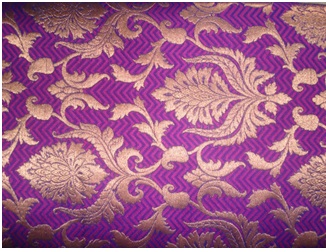
It0 is a rich jacquard fabric with intricate designs on its surface which looks as if they are embossed or 0embroidered but are made by weaving supplementary weft yarns(silk or silver/golden zari; sing0le color or multi-colored) into the warp on a special jacquard loom. The patterns can be simpl0e shapes like scrolls, flowers, or animals or as intricate as they come. This is mostly used in home 0furnishings, for making wedding gowns and costumes and to make jackets. You need a lightwe0ight brocade for making clothes. May have rayon fibers added.
00
- 0Banarasi Silk-
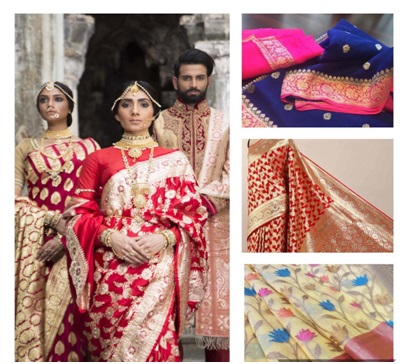
Banarasi Silk is a fine variant of Silk originating from the city of Varanasi in Uttar Pradesh, India. Saree woven from this fine silk, known as a Banarasi Silk Saree is extremely popular all over India and across the world. With a mention in the Mahabharata and in the Buddhist scriptures in the first millennium, Banarasi silk has its roots seeped into the rich cultural history of India. Originally crafted exclusively for the royalty, each Banarasi sari was created from real gold and silver threads, taking as much as a year to make. Persian motifs were being mixed up with the designs of Indian silk for creating this distinctive flowery pattern of Banarasi silk sarees. In the present days, Banarasi silk sarees are still considered to be one of finest traditional saris. It has actually been well known for its designing and gold as well as silver brocade or the ‘Zari‘. These traditional and beautiful Banarasi sarees are now recreating a new platform. Even five star hotels and resorts are now being decorated with Banarasi silks. In addition, Bollywood films and popular TV serials are also using the traditional Banarasi sarees for picturing the wedding and festive scenarios. There are four main varieties of Banarasi sari, which includes pure silk (Katan), Organza (Kora) with Zari and silk, Georgette, and Shattir, and according to design process, they are divided into categories like, Jangla, Tanchoi, Vaskat, Cutwork, Tissue and Butidar
- Kanjeevaram Silk-
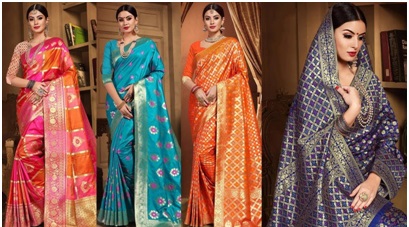
One of the most prized gifts to an Indian woman continues to be a richly brocaded handwoven sari, illustrating the central role of the beautiful drape. Over the past 500 years, silks from Kanchipuram have formed a fundamental part of the cultural tradition of the South Indian world. The sheer beauty of the fabulous silks of the South, with jewel toned colours enriched with threads of gold — the Zarigaipattu — has overwhelmed people. When we look at Tanjore paintings, temple murals and paintings of the royalties, we understand how the weavers have adopted and perfected temple art into weaving patterns in textiles. Kanjeevarams showcase the beautiful incorporation of golden thread by way of zari — thin strips of metal wound around a fibre core (a red strand of silk). Over the centuries, a range of several patterns has become characteristic of kanjeevaram saree designs. These motifs and patterns were not just decorative, but also had strong symbolic connotations, both in mythology and folklore. The pure mulberry silk used in the making of Kanchipuram saree comes from South India and the zari comes from Gujarat.That is the beauty of a Kanchipuram/Kanjeevaram saree. These sarees are woven in Kanchipuram, a small city close to Chennai, Tamil Nadu. The most distinguishing feature of a Kanjeevaram Silk saree is the heavily contrasted border and pallu. The border and pallu are both quite distinctive and are usually heavily embellished with gold or zari depicting traditional motifs like the lotus, parrots or peacocks and sometimes simple geometric patterns are used to add a subtle dash of glamour.
- Angora Silk-

A fabric that is soft, sensuous and screams tenderness, the Angora silk yarn is made up of the world’s softest thread. It comes from the meek ‘Angora’ rabbit. These rabbits have been used to harvest the Angora silk yarn for hundreds of years, with the origin of this yarn being in Turkey, it has prevailed over the fashion world with its softness in appeal and distinctness in quality.
- Art silk-

Art silk is short for artificial silk. It is manufactured by a synthetic fiber like rayon that very much resembles the silk fiber; however, costs a lot less on the front of manufacture and production. ethnic attires like art silk sarees, salwar kameez, and lehengas are made with art silk to keep the cost economical.
- Bomkai silk-
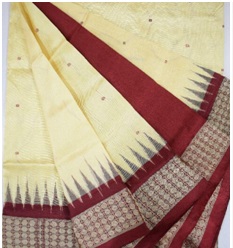
Woven on a pit loom, Bomkai, which is also known as Sonepuri, is an extraordinary fabric that results from the confluence of two extremely popular components of the Orissa textile industry. In its simplest, Bomkai can be explained as an extra weft technique on a pit loom. It is an outcome of ikat and embroidery interwoven into each other.
- Bangalore silk-

Bangalore silk is known for its simplicity, purity, and texture of silk, which is meticulously produced in the silk farms of Bangalore, Karnataka. These sarees are in great demand as the work enhances the already rich texture of the silk. Sometimes small beads, crystals and colored stones are used while decorating the sarees. They are also costlier than the traditional Sarees. Gold threads woven across the Silk Saree gives a rich look and is most sought after for weddings.
- Bhagalpuri silk-

The finest texture of silk springing out from the essence of nature and known as the ‘queen of all fabrics’, Bhagalpuri silk is very well known for its unique and striking resilience and superior quality. It is filled with every slice of Indian cultural aspects which are drawn from the intricacies of the natural surroundings and which are symbolic in its own form.
- ChanderiSilk-

Chanderi is a traditional ethnic fabric characterized by its lightweight, sheer texture and fine luxurious feel. Chanderi fabric is produced by weaving in silk and golden zari in the traditional cotton yarn that result in the creation of the shimmering texture. The fabric borrowed its name from the small town Chanderi in Madhya Pradesh where traditional weavers practice the art of producing textured sarees in cotton and silk decorated with fine zari work.
- Cot Silk-

Cot silk is a combination of two widely used fabrics – cotton and silk, hence, tuning the positives of both the fabric into one, defines cot silk. Belonging to no single tradition, this hybrid fabric has been accepted widely across the world. It is a cheaper version of silk but a more popular fabric than pure silk itself.
- Dharmavaram Silk-
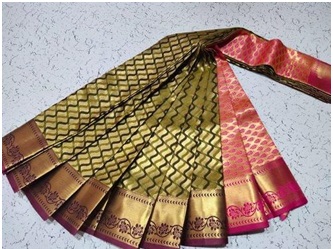
Spreading out its essence from the enriched land of Andhra Pradesh, this ethnic silk has imprinted a long-lasting statement style with its heavy colored borders which are accompanied by shaded pallus which enhance the intrinsically woven golden borders. Etched with traditional beauty and royalty, Dharmavaram silk saris have made it big and are renowned within the family of silk, as well as in the fashion world.
- Garad Silk-
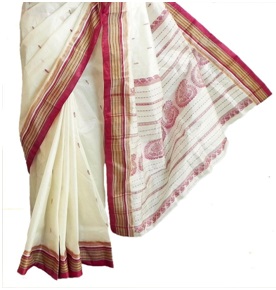
It is one of the popular styles of saree that has its origin in West Bengal. Also known as gorod, the word garad means ‘White’. garad silk sarees are distinguished by its red border and small paisley motifs. Silk fabric used to weave garad sarees is not dyed which keeps the purity factor of the fabric intact and therefore these sarees have a sacred importance to the women in Bengal.
- Jamdani Silk-
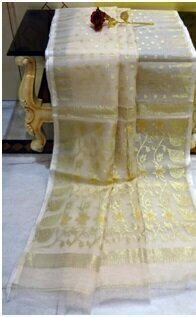
Jamdani, a word of Persian origin, is a combination of the words ‘jam’ and ‘dani’ meaning flower and vase respectively. This weave done by loom on brocade, it is a time-consuming process and is a blend of figures and floral motifs. Jamdani also known as muslin cloth has a weave of the typical gray and white, and sometimes a mixture of cotton and gold thread.
- Kosa Silk-

Kosa silk is obtained from an Indian silkworm – Antheraea mylitta and is a variety of Tussar silk. It is drawn out of cocoons which are especially grown on specific trees known as Arjun, Saja and Sal. Kosa silk is known for its sturdiness and is preferred to pure silk in the state of Chhattisgarh. known for its dull golden brownish look, it is available naturally in shades of pale golden, dark honey, orange, fawn, cream and many more, all similar to the description of dull golden brown.
- Katan Silk-

This silk is one of the most luxurious fabrics and is also extremely versatile as it can be successfully incorporated into any look. Katan silk is a type of silk that is created by twisting together filaments to create a sturdier and more durable fabric. Due to the nature of its creation, it also makes an interesting textured background for any work that is to be done on the fabric to make it unique. It is one of the most easily identified fabrics as it has a unique look that helps it stand out from other forms of silk.
- Matka Silk-

Matka Silk is a rough handloom silk fabric made from the waste mulberry silk (bombyx mori) without removing its gum (sericin) part. It is largely obtained from the states of Karnataka and Kashmir, but its spinning is done in the Malda and Murshidabad districts in West Bengal. Sujapur village in West Bengal, Islampur village in Bangladesh and Dariapur village in Gujarat are some of the well-knownMatka silk producing villages.
- Murshidabad Silk-

This Silk is something that can add that extra bit of elegance and spark to any attire, whether traditional Indian or western. silks have been made in India for centuries and their weaving varies from state to state, thus adding a new element to the texture, patterns, and style. Murshidabad also has a center of sericulture research and training institute, along with various NGOs that assist the silk weavers and rearers, to produce optimally and thus uplift this cottage industry.
- Mysore Silk Crepe-

The Mysore Silk Crepe is woven from hard-spun silk yarn and is one of the most widely used forms of silk across India. The Mysore Silk comes from the city of Mysore in Karnataka, India. The earliest mentions of the silken crepe fabric can be traced back to 1785AD. This was the time when the first silk cocoons were imported to Mysore. During Tipu Sultan’s regime, sericulture was formally introduced to Mysore. Thereafter, sericulture became one of the most important industries of Karnataka.
- Uppada Silk-
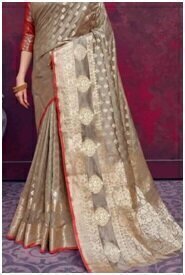
Uppada Silk is named after a small beach town of Uppada in East Godavari district of Andhra Pradesh, India. also known as uppadapattu (silk in telugu), uppada silk sarees are made from the age old jamdani method. known for the unique designs in them, uppada sarees are usually made with cotton warp. using only non-mechanical techniques, uppada silk sarees are defined by the length and breadth count of threads. The artisans also use a lot of zari work in the exquisite designs of uppada silk sarees.
- Khadi Silk-
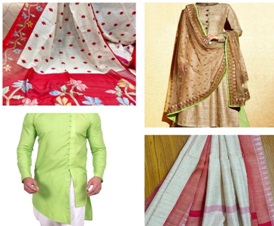
This is silk fabric made from handspun silk yarns. Khadi silk is usually 50% cotton and 50% silk. It has a very crisp and neat look and a soft lightweight feel
MULTIPLE USAGE OF SILK:
Silk is primarily used in garments and household items, but it is also employed in unexpected ways, such as in bicycle tires and in medicine. Silk is great for summer clothing because of its absorbent nature and how it wicks moisture, and it is also a staple for winter wear since it has low conductive properties. Here are some examples of the material’s many uses.
Bridal and formal wear: Silk is a staple of many gowns and dresses thanks to its beautiful drape, and the long floats of yarn on one side create a dressy and lustrous appearance.
Ties and scarves: The material’s strength and nuances with color make it ideal for accessories. Many high-end ties are made from heavy silk, which allows for tightly woven patterns, rich colors, and durable material. Silk is also a great material for scarves for both decoration and for warmth.
Bedding: Silk sheets are the height of luxury and the material’s softness and absorbent nature makes it truly shine in the bedroom.
Parachutes: Silk was originally used for parachutes for its strength and elastic properties; however nylon is more commonly used today.
Upholstery: Silk is used to cover furniture and pillows, and thanks to its strength and durability, it provides a long-lasting covering.
Wall hangings: Decorative wall hangings are often woven from silk, as the material is beautiful and dynamically reacts with colors and dyes.
Bicycle tires: The material is sometimes used in the tire’s casing because of its lightness, durability, and flexibility. Since silk can be expensive, the casings can also be made from nylon and cotton.
Surgical sutures: Since silk is a natural material, it has amazing uses in medicine. The material does not cause an autoimmune response and cannot be absorbed by the human body.
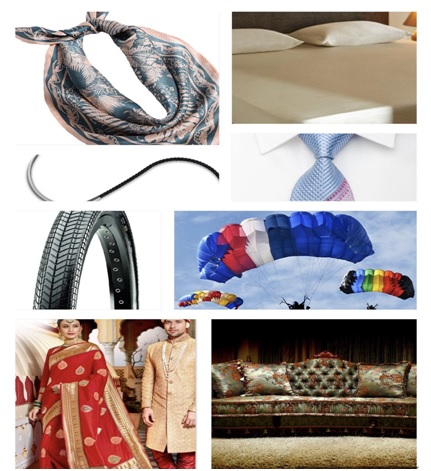
POPULARITY OF INDIAN SILK ACROSS THE GLOBE:
India has the unique distinction of being the only country producing all the five known commercial silks, Mulberry, Tropical tasar, Oak tasar, Eri and Muga. The silk goods exports from India comprise mainly items of natural silk, fabrics, made-ups, readymade garments, silk carpets and silk waste. The category of silk fabrics viz., dress materials, sarees and scarves & stoles constitute the bulk of silk exports followed by readymade garments with contribution around 60% and 30%, respectively to the total silk export earnings of the country. The Indian silk goods have high export potential because of their distinctiveness and low production cost. Indian silk exports, which reach more than 190 countries, have increased over the years. The demand for Indian silk is not only in the domestic market but in global markets too. The USA, UK, Italy, UAE, Germany, and Spain are the top importers of Indian silk products. Indian silk is steadily gaining greater demand in the new markets like Latin America and Russia also.
India, besides being a silk producer, is also the second largest silk consumer in the world. The demand and supply position is tilted to such an extent that India needs to import sizable quantities of raw silk to meet the domestic requirement. The saree industry consumes the lion’s share of the country’s domestic production of silk that is almost to the tune of 75%. While the traditional sarees are woven in handlooms, there are a few lightweight varieties, plain and printed, being woven in power-looms. Other items in production are dress materials, made-ups, ready-made garments, scarves and stoles, carpets and home furnishings.
Silk has always been associated with luxury and wealth. It is used for a variety of fashion related pieces. It can be used for skirts, dresses, blouses, scarves, pajamas, and lingerie. There are several manufacturers who have taken full advantage of the benefits of silk. Some of the designers who have been recognized for creating unbelievable silk designs include Prada, Chanel, and Roberto Cavalli. These world-renowned designers offer only the best of the best when it comes to their designer clothing and their customers are always happy with their purchases.
Indian Silk has aroused global interest since decades. This has swayed the design and fashion industries where elements of stylized motifs, colors and intricate designs have been an inspiration. Over the years, Indian Silk has carved out a niche market, the principal buyers being US and Europe. With global fashion influencing India and India influencing the global trends, one can see a reciprocal movement of fashion trends that is only going to become stronger in the current globalized environment.
Indian silk industry is one of the premier industries producing silk and it provides livelihood opportunities for millions owing to high employment oriented, low capital intensive and remunerative nature of its production. Silk has been intermingled with the life and culture of the Indians. Indian Silk has a global appeal because the soul and warmth of the culture is wrapped within the Indian designs. Indian Silk, with the perception of ‘looking good & feeling great’, undoubtedly is nature's performance fiber.
 1,12,000 Artisans families benefited so far
1,12,000 Artisans families benefited so far
